Expanding the Borders of a ‘Disney World of Food’
Aziz Osmani, owner of Kalustyan's (Photo by Marco Poggio for Voices of NY)
Change is always a constant in New York, but walking into Kalustyan’s in Curry Hill these days is still disorienting. This is not the store it once was. The owners aren’t ready to boast about it, but devotees are buzzing: It’s bigger, brighter, even better-stocked — what began as an Armenian grocery and became the essential source of South Asian ingredients is now a sprawling Model UN of food. With bitters as a bonus.
Kalustyan’s is usually described as an Indian grocer, and it remains, at 123 Lexington Ave. just north of 28th Street, exactly where you should head if you want to cook dosas and dals. Its shelves are overloaded with both the basics, from lentils in all colors to asafoetida to ghee, and more esoteric ingredients, such as amchur (mango powder) and nigella seeds. But it’s telling that one of the most recent references to the store as Indian was in an article on Lebanese olive oil. Which can be found alongside bottles from Spain, Italy and Greece — as well as alongside mustard oil from Bangladesh, stone-ground at that.
Those oils are among 20,000 products from 75 countries Kalustyan’s now carries, says partner Aziz Osmani, a Bangladeshi immigrant who bought the store in 1988 with a first cousin, Sayedul Alam. The oils are on display along with the likes of Korean kimchi and Kashmiri chilies, Ethiopian teff flour and Vietnamese fish sauce, Spanish smoked paprika and Turkish pistachios, not to mention rice from everywhere paddies are wet. Over the next few months Osmani expects the shelves to be filled with even more temptations, both for cooking and for eating out of hand (the Indian bagged-snack section alone makes Frito-Lay look like a single-item slacker). Although the store has always been a place where you could buy an Indian wok (aka kadai), he is slowly stocking an upstairs shop with more specialized kitchenware and gadgets for making everything you won’t find in tame tomes like “Mastering the Art of French Cooking.”
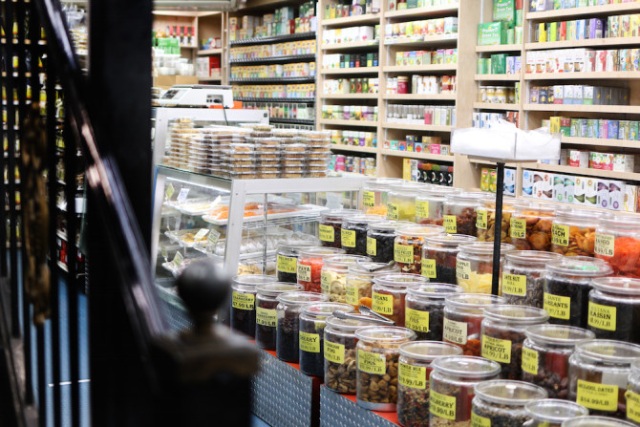
Inside Kalustyan’s (Photo by Marco Poggio for Voices of NY)
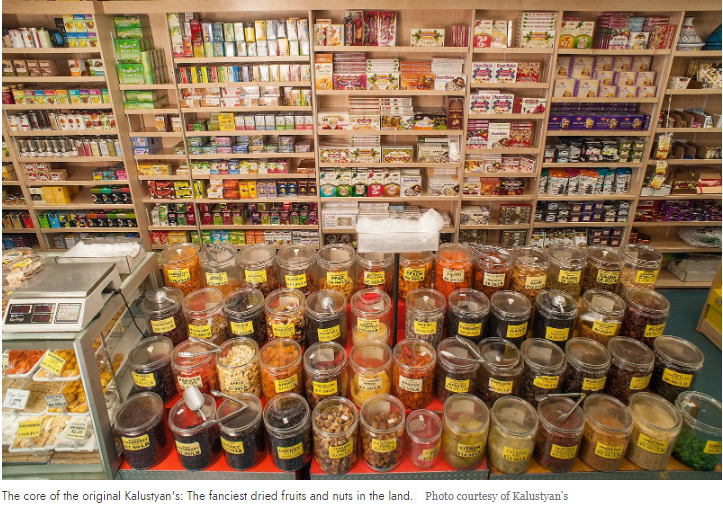
Even before it expanded over the last year into a third rented storefront, to a total of 6,500 square feet, Kalustyan’s was known internationally as a Disney World of food and locally as an immigrant success story. Today it’s more fascinating as a tale of evolution, a reflection of how the owners saw their clientele migrating and decided to go both big and long.
“Not the store it once was” is a description that could apply at regular intervals throughout Kalustyan’s history. The business was started in 1944 by an Armenian immigrant (whose given name was reportedly Kerope) to cater to residents of what was then known as Little Armenia. It went through another owner before it was sold to Alam, who owned a nearby spice-and-sweets shop, and Osmani, who had come to work at his cousin’s Curry in a Hurry restaurant down the block, as the neighborhood was becoming more populated by South Asians and morphing into Curry Hill (a play on Murray Hill). As those immigrants moved out over the last 30 years, displaced by rising rents to neighborhoods like Jackson Heights, the owners wisely broadened their borders.
“When we came in it was mostly ethnic customers — Middle Eastern, some Indian Asians,” Osmani says. “The foodies, the professionals, started coming in the late ’90s. Then we started bringing in increased inventory for customer demands. The media started slowly, slowly seeing Kalustyan’s as a reliable source of new products, and we became an institution for professionals from inside the country and from outside.” Once Kalustyan’s started to be listed in guidebooks along with Zabar’s and Balducci’s, he says, “we became a destination store.”
Michael Camerini, a documentary filmmaker who lives in shopping-tote distance and has been provisioning there for nearly 40 years, calls the store “one of the food temples of the city, along with Murray’s Cheese and Russ & Daughters.” It’s a place where he takes friends from out of town and from out of the country to dazzle them but more where he heads regularly because “if you want to try a recipe that makes no sense, you can find everything” to make it work. “If you like to cook and want to try another cuisine entirely, it’s amazing — everything is there.”
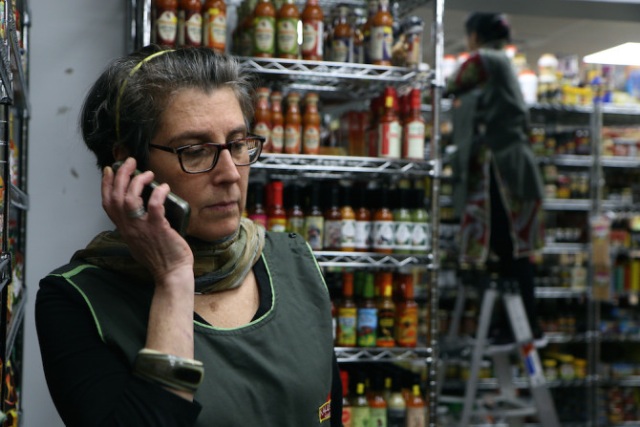
Dona Abramson, a chef and former food shop owner now working at Kalustyan’s (Photo by Marco Poggio for Voices of NY)
Osmani says Kalustyan’s has a huge following among chefs, restaurants, hotels and the Food Network’s viewers and stars (“all the celebrities, they come here or they send their people — Emeril, Rachael Ray, Bobby Flay, Martha Stewart”). Many have lauded it on their television shows and blogs, Stewart and Indian cuisine legend Madhur Jaffrey in particular. The store still attracts many first- and second-generation immigrants, as well: Southeast Asian, Palestinian, Lebanese, Israeli, Iranian. But the new blood is more young cooks shopping for international ingredients especially as interest grows in Korean and Middle Eastern, including Israeli, thanks largely to the influence of David (Momofuku) Chang, Roy (Kogi) Choi and Yotam (“Jerusalem,” “Plenty”) Ottolenghi and Michael (Zahav) Solomonov.
To cater to these customers, Osmani hired Dona Abramson, a chef whom he got to know when she ran Bright Food Shop and the Kitchen in Chelsea, which specialized in Mexican food and products. (“I believe I’m the first English-as-a-first-language employee” among the 22 to 25 on staff full- and part-time, she says.) She joined Nigel Chaudhury, a manager who started while still a student at CUNY, sourcing and researching products and then condensing his findings onto often-tiny and always near-lyrical labels.
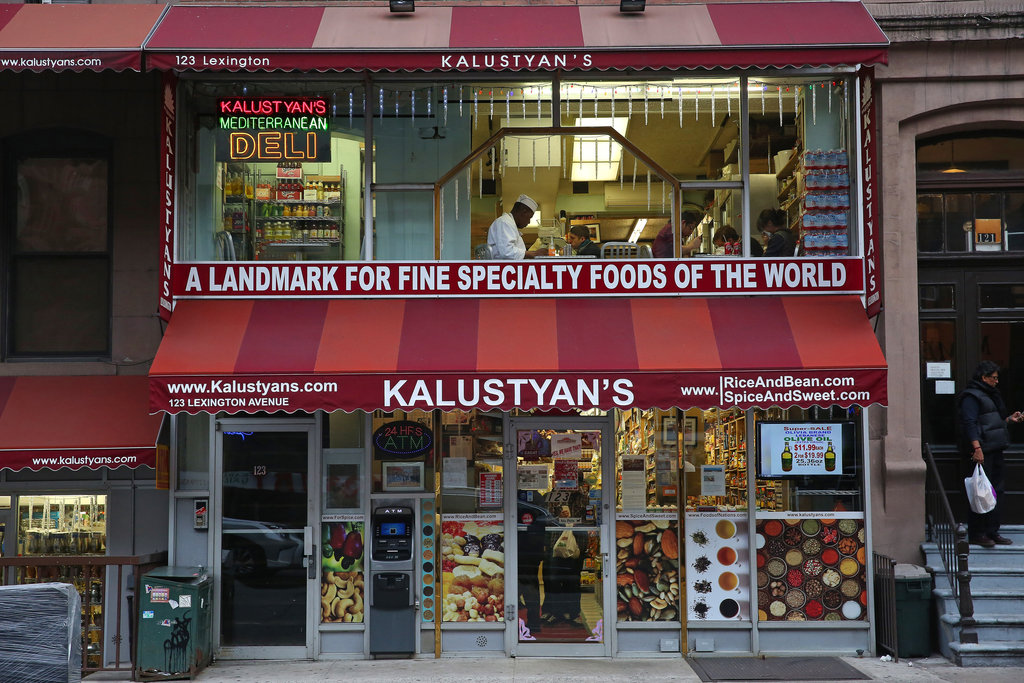
Beyond the change in clientele, Osmani notes another reason for the store’s evolution. As immigration has increased in New York, so have shops that cater to new arrivals. Indian, or Russian, or Mexican, or Salvadoran communities now tend to have their own stores, in their own neighborhoods. “So they don’t need to come here for their day-to-day shopping,” for their parathas and rice, he adds. “The customers we have are a bit different, so we try to specialize in specialty items. We try not to have what you can get at any supermarket or bodega. We focus on the hard-to-find item. That’s why people come here. Because of our extensive variety in every category. Say rice, for example. We have five dozen varieties of rice. I’m sure nowhere else in this country has that much variety in one store. Every category is like that — paprika or peppers or chilies or salt. Or bitters. In every category, you name it, we have so many varieties.”
Having the United Nations nearby also does not hurt. “They all come here,” Osmani says.
And it is not hard to see why. Something like cardamom that most stores carry only in green, if at all, is stocked in white, red and black versions. Cumin is available whole and ground, of course, but also black, white and roasted. Kalustyan’s carries cinnamon from Ceylon, Mexico, Indonesia, Vietnam and China; it has nut flours, chickpea flour, farofa from Brazil, barley, grits, cassava meal, freekeh, barley and einkorn and many more grains.
Among its sprawling cornucopia can also be found dried herbs on the vine from Greece and Sicily, sour cherry products to cater to Iranian customers, shelf-stable, ready-to-eat Indian meals, Irish butter alongside labneh. It has a wall of salts, from Antarctica and the Kalahari Desert and Italy and Germany and Cyprus. (“People want the flavor that’s part of the origin,” Abramson says.) It also carries a global array of even things as basic as sugar: Belgian, Balian, Japanese, jaggery, coconut, palm.
Thanks to the expansion, Kalustyan’s also now has a small selection of fresh produce, including lemongrass, Kaffir limes, bitter melon and of course curry leaves. Freezer cases hold Middle Eastern and South Asian snacks, vegetables used in Middle Eastern cooking like baby okra and double-peeled favas, fruit purees and Indian desserts like kulfi. The store also sells a few halal meats, including quail, squab and rabbit. It has no pork products but does stock items like lamb merguez and Lebanese beef sausage. Its kitchen has also expanded and produces even more than the old, impressive array of tabbouleh, dolma, hummus, mujaddara, falafel, chutneys, preserves and pickles.
Not everything is ethnic, however. The molecular gastronomy aisle includes gelatins and pectins and curing and citric salts as well as cheesemaking supplies – “everything from meat glue to butter powder to vinegar powders,” Abramson says. With all the interest in mixology, she is also constantly adding new products for cocktails.
Increasingly, though, she is investing in more locally produced products with foreign-to-America flavors, such as the Essiespice line from Princeton made by a Ghanaian immigrant and the Momofuku array from David Chang. (Like Kalustyan’s itself, both those companies offer online ordering.)
With so much more room, Osmani has also added a new room stocked with herbal and ayurvedic products, supplements and fruit powders for making smoothies. A longtime upstairs deli, which grew out of a counter under the stairs, now has more room for seating as the tea selection has been moved downstairs. The chef, an octogenarian named Arpiar Afarian who is Lebanese-Armenian, is renowned for his Middle Eastern vegetarian food. As Osmani notes, “He was actually working at Kalustyan’s before we bought the place and so, in a way, he came with the place.”
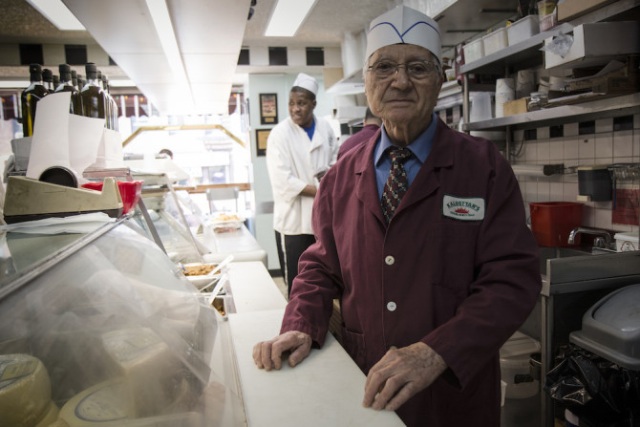
Arpiar Afarian has prepared Middle Eastern specialties at Kalustyan’s for decades. (Photo by Marco Poggio for Voices of NY)
Ask Osmani for his bestsellers and he will rattle off many, in many categories along with bitters: medjool dates, apricots and figs among dried fruits; pistachios, almonds and cashews among nuts; basmati, Forbidden, saffron, bamboo and wild among rices; lentils de Puy, beluga and red among lentils; Aleppo pepper, zatar, vadouvan, ras el hanout, poppy seeds, Tellicherry peppercorns and peperoncino among spices, along with salts and hot sauces from around the world.
Osmani says the store “never closed, for even one hour,” during all the months of construction. His partner, he notes, is an engineer “and that experience was very helpful.” But it is Osmani who is running the store. From the beginning, “I was the stockboy, manager, owner, receiving boy.” He notes that the cousins have opened, and closed, quite a few restaurants over the decades, including Kalustyan Cafe and Curry Leaf. But the restaurant business is even more demanding than shopkeeping when it comes to an owner “being there.”
Osmani will not disclose sales figures for the store, but he does say the numbers are up since the expansion: “More merchandise means more sales — it’s simple math.” Not everyone is happy with the expansion, though. Shola A. Olunloyo, a consulting chef in Philadelphia who drives up every four to six weeks to stock up, worries that the bright light and warm temperatures in the now-sprawling store have a detrimental effect on spices. (But he still shops there every few weeks because “Kalustyan’s has everything!”)
The prices are also not exactly Costco level, Olunloyo adds. Shops next door and across Lexington Avenue sell the likes of ghee and gram flour for less. The store gives customers who pay in cash a discount.
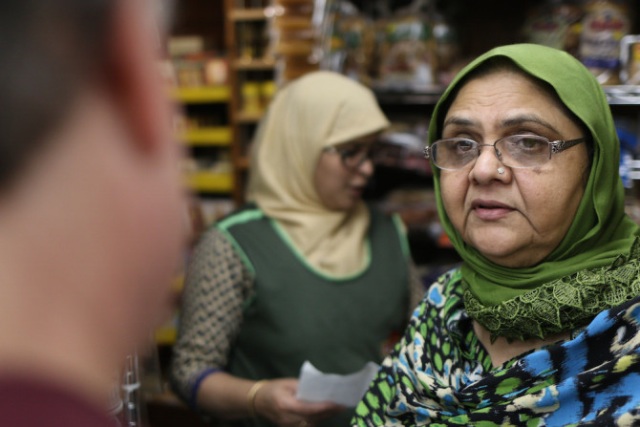
Rubina Alam and coworkers at Kalustyan’s (Photo by Marco Poggio for Voices of NY)
Kalustyan’s also supplies restaurateurs with chile powders and spices in bulk as well as its increasingly in-demand spice mixes, but Osmani says Kalustyan’s collaborates with a separate business in New Jersey, started, as it happens, by the previous owner of the Lexington Avenue store, John Bas. That Kalustyan, primarily a spice dealer, takes over when even the newly expanded store can’t handle a 50- to 100-pound order of Aleppo pepper, say, and a customer needs half a ton.
“People will come here because they know we have everything,” Abramson says. “If one person asks for something, we probably won’t get it. If two do, we will. If four people call for something, we figure it must be written up somewhere. Even if Kalustyan’s is not listed in the story, people will know we have it.”
Camerini, who takes a global approach to both filming and cooking, notes that he can find both Moroccan preserved lemons (imported and store-made) and Indian lime pickle in one swing through the store. “Two different cuisines, and both are there.”
Or, as Osmani puts it: “It makes me so proud to see the shopping baskets of customers. I see paprika, I see couscous, I see truffle oil, I see Sicilian pistachios — in one basket, I see the connection. These are very educated customers who have been to many countries; they’re well-traveled and know about food. It makes me so proud to see shopping baskets with products from India and Mexico and Japan and Italy and Morocco.”
And bitters, too.
(Published 2017/07/01 at 9:44 pm)
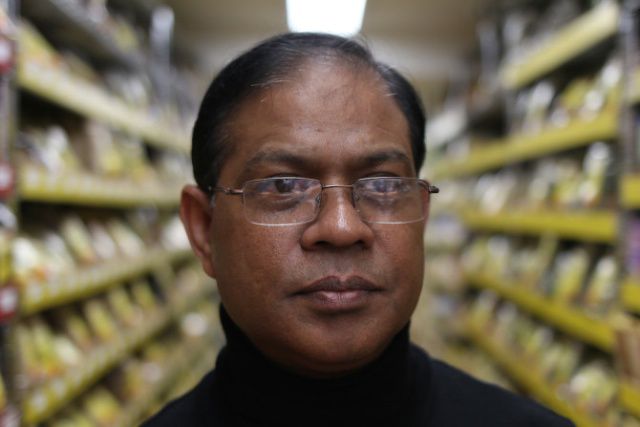













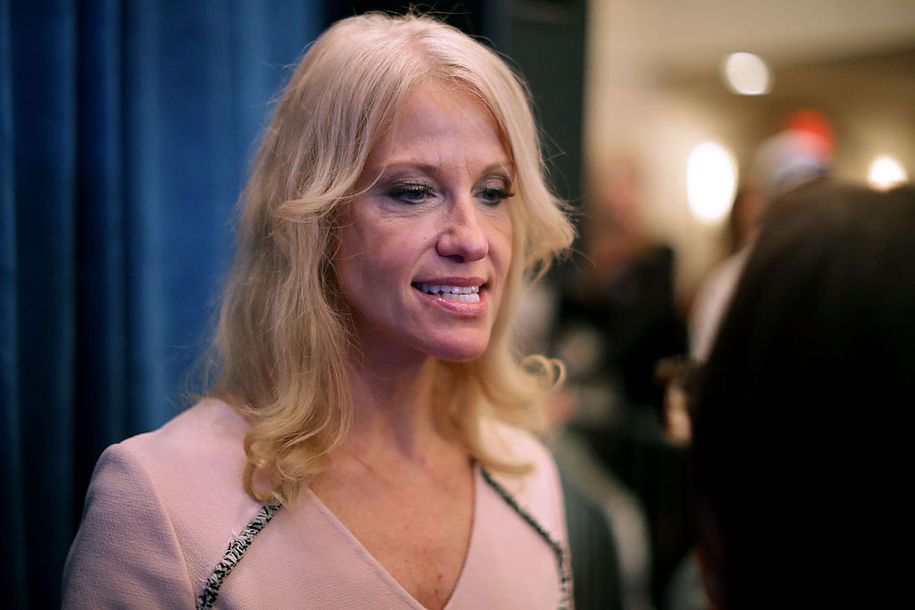
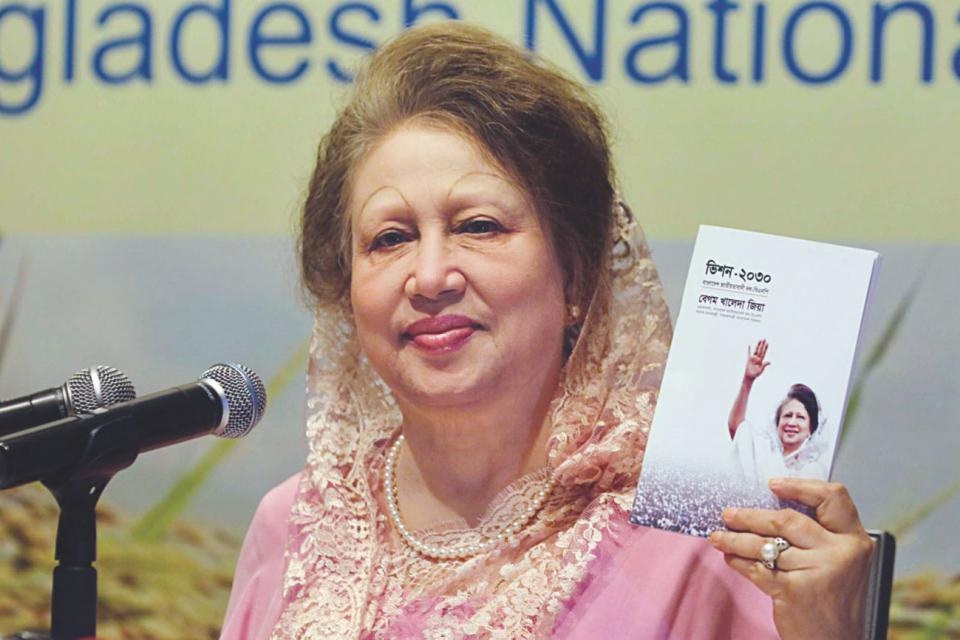
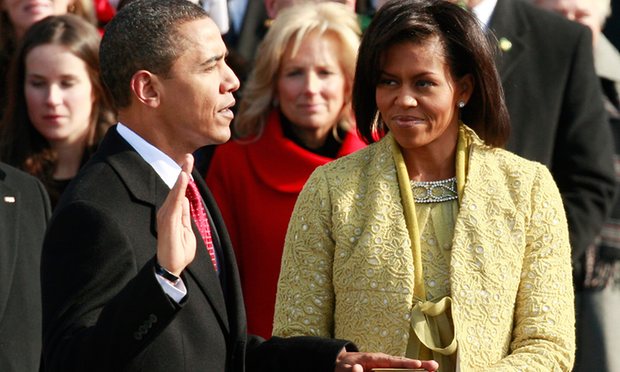



Comments